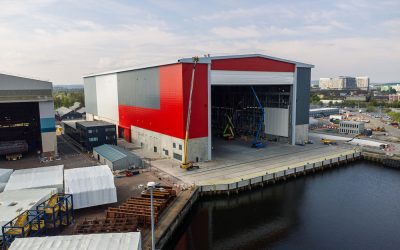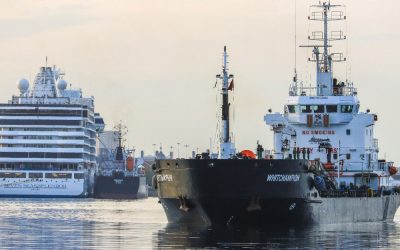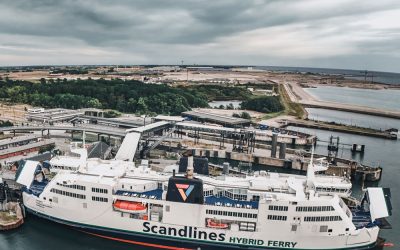Mikko Forss, executive vice president for design solutions, NAPA
Ship designers today are building vessels for an economy and tech landscape that might look very different from ours today. Last year, the average age of a container ship was 14 years. Depending on your age, 2009 may or may not just feel like yesterday – but this was a world where Uber and Airbnb had only just launched, we’d only had iPhones for two years, and no-one was going to join a Zoom meeting for the next three years. Just 3,884TW of energy came from renewables in 2009 – it’s more than doubled to 8,538TW now. The same ships are sailing through a world that has changed fundamentally.
Those designing ships now need to think on a similar timeframe, accounting for technological unknowns, and a much greener maritime economy. Maersk’s methanol-fuelled Laura Maersk, recently named, marks – hopefully – the beginning of a new generation of vessels. And while the IMO’s latest ruling at MEPC 80 has had a mixed reception, there’s reason to believe this regulation could usher in some big changes. A recent evaluation from academics at UMAS has found that, even at the lowest ambition interpretation of the strategy, an average ship’s GHG intensity will need to be reduced by 86% by 2040.
Designing for the unknown
Making this a reality starts with the design process – from prototype design and beyond, as new ships make their way from concept to reality – and the creativity and ingenuity of the designers and structural engineers at each stage. This means the next few years are pivotal – and a major opportunity for those who embrace the challenge. The Japan Shipbuilders’ Association forecasts that the transition to carbon neutrality will drive a rapid expansion of the shipbuilding market in the next decade, which is expected to surpass historical peaks.
In this context, key considerations for shipyards will be twofold. Firstly, how to streamline the design process to boost their own productivity and protect their businesses’ commercial viability. The more moving pieces to manage, the more important it becomes to have efficient processes in place. Naval architects and structural engineers need more streamlined and efficient tools to create their designs and get them approved.
Secondly, in addition to being fast, designers will need to innovate and create next-generation vessels efficiently, by making the right decisions throughout the design process to deliver the best possible outcome for their customers. In practice, this means being able to test different configurations easily, make changes quickly, and manage information in smarter ways.
Design challenges in the future fuel era
This 86% less GHG-intense future relies on designs that can accommodate new fuels. The energy transition increases demand for “future-proof” designs, such as ships that are ready to be converted to methanol or ammonia, or retrofitted with energy saving applications (such as wind propulsion), at a later stage. These designs require allocation of space for additional storage tanks or ensuring that the ship structure will be adapted for wind propulsion, for example.
For the people in charge of creating and building those ships, this growing focus on new fuels and power systems has a direct consequence: it increases the complexity of designs.
While it has always been the case that no two vessels are exactly the same, the number of variables involved in today’s designs make them more complex and unique than ever. The single-fuel era is, inevitably, behind us – moving forward, ships will be powered by a broader range of fuels, technologies, and alternative energy sources, all of which have their own specifications and implications for the vessel’s structure, stability profile and general arrangement.
For instance, the storage of hydrogen requires at least twice as much space compared to conventional fuel oil, depending on the technology selected. Similarly, using ammonia as fuel will require the installation of additional fuel tanks and safety systems. Furthermore, because of their flammability or toxicity, some fuels will require specific configurations to ensure that tanks are isolated from accommodation or any sources of heat, or to provide additional ventilation systems, for example.
Therefore, switching to a new fuel is far more complex than just changing a ship’s engine and tanks – it impacts fundamental aspects such as the vessel’s stability, weight, and structural integrity. For naval architects and structural engineers, the challenge will be not only finding ways to integrate new systems onboard, but to do so while ensuring the ship’s safety and stability. Being able to navigate this complexity efficiently, while also respecting increasingly challenging time constraints that many shipyards face today, will be essential to flourish in this new era.
The right tools today for tomorrow’s ships
Designers might not be able to affect future technology choices, but they can make sure they are using the best tools available today to set ships up for success.
A key place to start is by making a greater use of 3D models in the ship design information management process. One challenge is to enable the vessel’s 3D model to be used consistently as a “single source of truth” throughout the design process. A single, consistent model allows better communication and collaboration from the early concept stage through to classification approvals, and then through detail design, and all the way in downstream production design. Beyond that, a digital model has continued utility as the basis of a digital twin throughout the lifecycle of a vessel, providing valuable performance insights and preserving essential details for repair and maintenance operations.
A ship design is an iterative process that typically involves several teams in charge of structures, propulsion, electrical, general arrangements, weight estimations, etc. Using 3D models as the central source of information on a ship design helps break silos, ensures data consistency between disciplines, and enables those teams to communicate more efficiently. Not only does this save significant time and minimises duplicate input, but it also helps avoid costly errors in the downstream process.
Going forward, the increasing need for real-time information exchange and efficient feedback loops will be another key driver towards a single model that facilitates co-ordination between the disciplines and external stakeholders. This reduces the time spent on data input and conversions, allowing teams to focus on what they do best: delivering the best possible designs. As cross-industry collaboration grows in importance the single model will play a vital role in enabling this, while ensuring IP protection – and simultaneously front-loading important decisions and challenges in the design process to achieve optimal, future-proof design.
The next generation of simulation
In addition to using 3D tools for a more efficient process, the next frontier will be to make the most of their potential to support decision-making. 3D models will unlock even greater opportunities going forward, including the possibility to use next-generation simulation tools that can model the future ship’s performance in actual sea conditions from the very early design phase. In short, thanks to 3D models, naval architects and structural engineers will be able to compare different alternatives from the outset to deliver the best possible concepts for their clients.
This is more than a theoretical prospect – simulation tools can already deliver a variety of assessments, including virtual voyage simulation, alternative fuel comparison, wind-assisted propulsion simulation, load case simulation, and flooding risk management and accident response.
This is an essential asset for the multi-fuel and multi-technology era ahead. In practice, simulation tools enable teams to assess and test different fuel and technology options, with a comprehensive view of their implications for the ship’s configuration, cargo capacity, stability, and even its future performance.
Just like it’s impossible to imagine a pre-Zoom existence, or a world where a methanol-fuelled containership seems radical, we can’t predict what kind of world the ships we design today will come of age in. But if yards, designers and structural engineers, along with others such as class societies and owners, make smart design decisions now, we can make sure they are set up for success.






